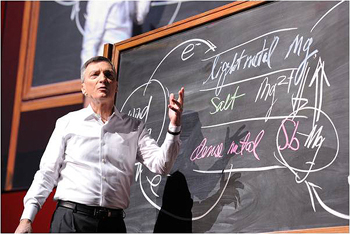Liquid Metal Battery lands another high-profile investor
 Liquid Metal Battery Corp., the startup spun out of MIT by Professor Donald Sadoway, has attracted backers Bill Gates and Total. Now, the early-stage company has raised another $15 million, in a funding round led by Khosla Ventures, to help commercialize its liquid battery technology and bring cheap grid-scale storage to the grid.
Liquid Metal Battery Corp., the startup spun out of MIT by Professor Donald Sadoway, has attracted backers Bill Gates and Total. Now, the early-stage company has raised another $15 million, in a funding round led by Khosla Ventures, to help commercialize its liquid battery technology and bring cheap grid-scale storage to the grid.LMBC also announced Andrew Chung, a partner at Khosla Ventures, has joined the board.
The researchers behind LMBC are working on a game-changing storage technology that’s cheap, easy-to-make, modular, reliable and can be competitive without subsidies. If they’re successful, their liquid metal battery could help bring more renewable energy projects onto the grid.
Variability is a big problem for renewable energy. When the sun sets, the renewable power source drops off. That can cause problems for grid operators trying to maintain a steady electricity supply. Enter LMBC, which is working on technology that will help level the load — and end intermittency — of renewable energy.
How it works
Sadoway didn’t want to develop tech and then find ways to lower the cost through economies of scale — a route other startups have taken. Instead, he wanted to invent to the price point of the electricity market, Sadoway said in during an April 2012 TED talk. In other words, use cheap, abundant materials that can be easily assembled.
For inspiration, Sadoway turned to the production of aluminum, which doesn’t store or generate electricity, but consumes it.
Sadoway made the battery all liquid. Those liquid components naturally settle into distinct layers because of their different densities. Each layer is made of cheap, widely available materials.
Two liquid metal materials form the positive and negative poles of the battery. An electrolyte layer, which allows charged particles to cross through as the battery is charged or discharged, is located in the middle.
Sadoway used magnesium as the negative electrode on the top layer; molten salt as the electrolyte and antimony as the positive electrode on the bottom layer. To produce current, the magnesium loses two electrons to become magnesium ions that travel through the electrolyte to the other electrode. Upon arrival, it accepts two electrons from the antimony and mixes with it to form an alloy.
To charge the battery, it’s connected to a source of electricity. The current is reversed and pushes the magnesium out of the alloy and across the electrolyte, where it joins the negative electrode. The current passing through the electrodes generates enough heat to keep it at temperature, Sadoway explained during his TED talk.
Khosla’s investment in the startup makes sense. Its founder Vinod Khosla has publicly criticized lithium-ion batteries as an overhyped technology and has largely dismissed other energy storage ideas. But with LMBC, Khosla sees promise. LMBC has developed the most innovative chemically0-based solution that we’ve seen, Chung said.
It helps, of course, that Khosla and LMBC are aligned on a singular idea that successful, widespread energy solution must be cost-effective, reliable and easy to manufacture.
The startup still has a ways to go before it can commercialize its product. During the TED talk, Sadoway said one goal is for LMBC to develop stackable modules to form a giant battery that would fit into a 40-foot shipping container. The giant battery would have a nameplate capacity of two megawatt-hours, enough energy to meet the daily electrical needs of 200 American households.
You can return to the main Market News page, or press the Back button on your browser.

